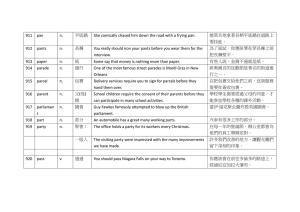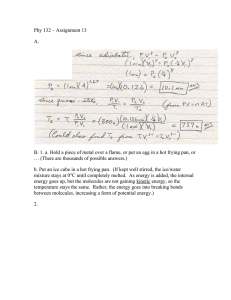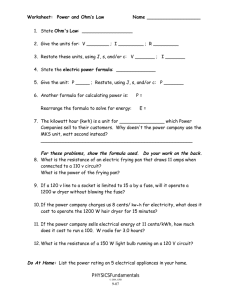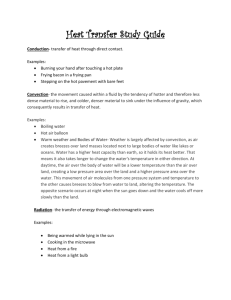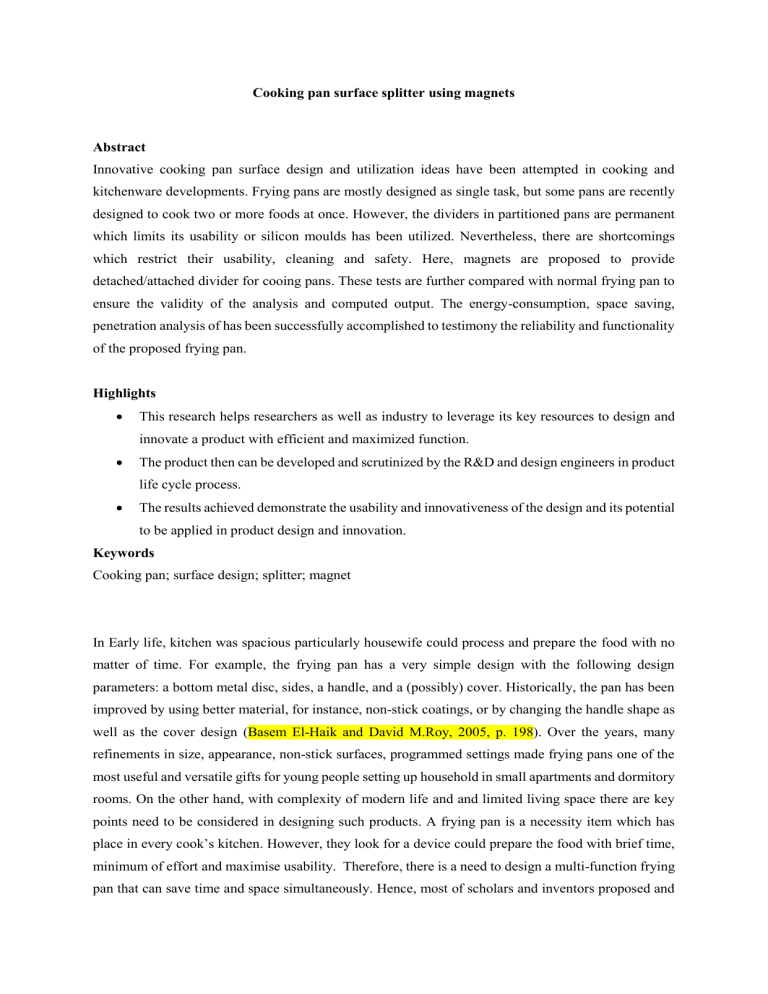
Cooking pan surface splitter using magnets
Abstract
Innovative cooking pan surface design and utilization ideas have been attempted in cooking and kitchenware developments. Frying pans are mostly designed as single task, but some pans are recently designed to cook two or more foods at once. However, the dividers in partitioned pans are permanent which limits its usability or silicon moulds has been utilized. Nevertheless, there are shortcomings which restrict their usability, cleaning and safety. Here, magnets are proposed to provide detached/attached divider for cooing pans. These tests are further compared with normal frying pan to ensure the validity of the analysis and computed output. The energy-consumption, space saving, penetration analysis of has been successfully accomplished to testimony the reliability and functionality of the proposed frying pan.
Highlights
This research helps researchers as well as industry to leverage its key resources to design and innovate a product with efficient and maximized function.
The product then can be developed and scrutinized by the R&D and design engineers in product life cycle process.
The results achieved demonstrate the usability and innovativeness of the design and its potential to be applied in product design and innovation.
Keywords
Cooking pan; surface design; splitter; magnet
In Early life, kitchen was spacious particularly housewife could process and prepare the food with no matter of time. For example, the frying pan has a very simple design with the following design parameters: a bottom metal disc, sides, a handle, and a (possibly) cover. Historically, the pan has been improved by using better material, for instance, non-stick coatings, or by changing the handle shape as well as the cover design (Basem El-Haik and David M.Roy, 2005, p. 198). Over the years, many refinements in size, appearance, non-stick surfaces, programmed settings made frying pans one of the most useful and versatile gifts for young people setting up household in small apartments and dormitory rooms. On the other hand, with complexity of modern life and and limited living space there are key points need to be considered in designing such products. A frying pan is a necessity item which has place in every cook’s kitchen. However, they look for a device could prepare the food with brief time, minimum of effort and maximise usability. Therefore, there is a need to design a multi-function frying pan that can save time and space simultaneously. Hence, most of scholars and inventors proposed and
designed a frying pan with different functionalities. A frying pan was designed to make the frying process more rapid than heretofore. The author’s invention consists of central fountain for containing grease and divided into different compartment by radial partitions which is suitable opening in the wall of the former (Malin, 1875).
Generally, a frying pan is divided into two parts: material usage and surface design. In this paper, the surface design is studied. Most of the works have been widely used in material usage or less ergonomic design (Harper, 23 July 2012; Malin, 1875; Papathanassoglou & Georgouli, 2009). However, the works done in designing pan still did not fulfil the requirements such as energy-saving, usability, space-saving and cost-efficiency. Currently, each pan is doing single task namely frying. In the market, numerous types of the pans are doing just single task; either frying, steaming, or cooking, etc. However, we can design a pan do all tasks which is called multi-task function that can maximize the usability of pan.
Another issue is the space-saving. Currently in modern life, kitchens have small space. However, due to lack of enough space for having several types of pans for several purposes e.g. several ingredients, we need to keep variety of pans which occupy the kitchen space. In addition to energy-consumption, normal design of pan can cook only one task namely steak, chicken or fish in three different periods of time or using three pans for each that can consume lots of energy. However, with the increase of energy consumption and global warming (Mohd, 2015), there is a concern to develop a multi-function device.
In such circumstances, an essential analytic of modern life has been the phenomenon of consumption, intelligent and automated technologies . The objective of this research is to improve the effectiveness of usability, energy-efficiency, and space-saving of normal cooing pan. This research focuses on designing a customizable multi-function pan which can be partitioned in to maximum 4 slots based on the user desire by detachable/attachable splitters using magnets to improve the efficiency of the pan. Moreover, energy consumption and space saving of the design are validated by S-curve based on the results achieved in experimental design.
Consequently, the partitioning of cooking surface suing magnets is devised and tested. The essential objectives comprising the surface division according to user desire into one to four parts simply using magnet, quick cooking process, and lower cost are achieved. Moreover, the proposed methods functionality are validated using S-curve for energy consumption and surface usability.
The approach to develop the multi-function pan
Overall the new product development usually comprises important level of market and technical vagueness, which defines that the excessive cost integration will be a necessity for NPD
accomplishment (Souder, William E., J. Daniel Sherman, and Rachel Davies Cooper, 1998). In addition, to hel in the assembling of the NPD application from innovative technologies, prototype construction in NPD in consistent process, opportunity analysis, assessment of market attractiveness, market research, and financial analysis should be considered initially (Veryzer, Robert W, 1998).
Therefore, NPD based on researches and find gaps which leads to develop an innovative product that can minimize the cost and maximise the product functionality and market acceptability.
Researches show the most promising categories of frying pans, focused more on material usage and design to function single task which leads to utilise high human force and non-renewable energy sources to manufacture these products in massive quantities. Each frying pan has named and designed to do one of the cooking methods which are very diverse. On the other hand, owning several types of pans require so much space which is unnecessary in daily chaotic life.
For frying pans, we require higher efficiencies in usability, space saving and energy consumption. Using a single task and unoptimizable frying pan results in large space and energy losses, in addition to the expensive material usage and energy sources. We therefore devised a multi-function frying pan using detachable/attachable dividers using magnets which gives a cook options to portions the pan into desired of maximum four slots or whole as one pan to cook family portion meals.
Stimuli
Frying pans are made and marketed in many design and sizes to be used for different cooking methods.
However, those are designed to do single task, and this makes this product to be designed and produced in massive quantities to do one specific cooking method such as frying, sautéing, etc. Thus, we manipulate the conceptual design of the product to validate the product functionality. Consequently, a prototype is made in small dimension and considered to be portioned into two portions than four in conceptual design. This prototype is manufactured to validate the multi-function frying pan using detachable/attachable dividers which gives more options to a cook to partition the pan into desired parts to carry out one to four foods simultaneously. Moreover, the space saving (usability) and energy consumption are evaluated by using S-curve based on the results achieved. Both conceptual design and prototype had identical differences but no differences with respect to the product’s objective usability were present in conditions considered to build the prototype and carry out the experimental test at real cooking environment.
The prototype parts are shown in colour photo quality. The presented technical specifications were considered standard features for the prototype dimension and material used.
Designed Small box (i.e. frying pan), divider with slot
Figure 1 presents the sample produced to carry out the experiment. In this design, our goal is to validate the magnet use to achieve attachable and detachable splitters for cooking pans. Therefore, we designed our devices to experiment that how much time magnet can prevent penetrating.
Figure 1, the small-scale mock-up made of stainless steel with dimensions H= 40mm, L= 60mm and
W= 26mm.
Independent variables
In this frying pan with two sections (as it is our assumption in this experiment), we carried out our experiments with four different independent materials namely water, olive oil, sesame oil and corn oil in amount of 25mml from each to evaluate the penetration.
Dependent variable
Based on the review, the Alnico magnet is selected as the proper alternative magnet. This selected magnet with the dimension Height: 25mm and Diameter: 5mm, was used as an attaching/detaching tool for the divider which very quick and convenient way to make the splitter detachable. The details are illustrated in Table 1.
Table 1: Alnico - Magnetic properties.
Grade Type Br
(kGauss)
Hc
(kOersteds)
Hci
(kOersteds)
BHmax
(MGOe)
Temperature
Coefficient
Maximum
Operating
Br
(%/ °C )
Temp
8 S Sintered 7,000 1,900 5.0 -0.013 540(°C) ⁓1000(°F)
Alnico magnets are made up of a composite of aluminium, nickel and cobalt with tiny amounts of other elements added to enhance the properties of the magnet. Alnico magnets have good temperature stability, good resistance to demagnetization due to shock but they are easily demagnetized. Alnico magnets are produced by two typical methods, casting or sintering. Sintering offers superior mechanical characteristics, whereas casting delivers higher energy products (up to 5.5 MGOe) and allows for the design of intricate shapes. Two very common grades of Alnico magnets are 5 and 8. These are anisotropic grades and provide for a preferred direction of magnetic orientation. Alnico magnets have been replaced in many applications by ceramic and rare earth magnets. Table 2 illustrates the positive and negative specification of Alnico magnet.
Table 2: Positive negative specification of Alnico magnet.
Positive
High Corrosion Resistance
High Mechanical Strength
Negative
Excessive cost
Low coercive force
The Alnico magnet can tolerate the temperature with maximum 540 °C. This tolerance is ideal to carry our experiments with different trials. However, to process our experiments with the small-scale mockup made of stainless steel (H= 40mm L= 60mm W= 26mm), the following procedures are applied.
Procedure
In this experiment, the Alnico8 magnet is chosen to be used as very quick and convenient way to make the splitter detachable. The independent, dependent and controlled material are selected accurately. The design procedure was repeated in two different environmental conditions and with four repeated trials.
The obtained design was agreed with hypothesis and succeeds.
Table 3 . Experimental design procedure
Procedure of small-scale mock-up
Implement RTV silicon on the spaces between detachable splatter and the box to seal the open holes which is occurred due to some minor error during manufacturing.
Pored the water till the index line
Measured the time over specific period
Repeat the first trial for 4 times with water (independent variable)
Repeat the procedure using Olive oil, Sesame oil, and Corn oil
Experimental results in normal condition room temperature
In this section, the experiments are conducted with independent and dependent variables in normal condition room temperature. As a result, the independent variables (olive oil, sesame oil, and vegetable
(i.e. corn) oil) did not penetrate the other part of the device (over 8 hours period) which is divided into two sections with magnets (Alnico). However, for case one (water) a little amount of water is flowed after 7 hours.
Experimental results with heat
The experiments are carried out with four types of liquid as dependent materials) for penetration examinations. Moreover, for heating we used a gas with following specifications:
Gas Butane (LPG)
Gas consumption (166g/hr)
Heat efficiency 50 percent
Consequently, we pour water into the one section of small-scale mock-up for penetration experiment
(as intimated earlier penetration tolerance of water is over seven hours and other trails are over eight hours) and measuring time of boiling points which is shown in Figure 4.
Simulated designs of frying pan
In this , we carried out two types of designation: Simulated and Experimental designs.
Simulated designs using CATIA P3 V5R18 software is elaborated as follows.
As shown in Figure 2, it is a base view of frying pan. In the disk of pan, the divider/splitter is embedded firmly into a groove to portion the pan. The magnetic detachable/attachable dividers assist us to cook multiple recipes simultaneously. In addition, it saves energy, time and space as well. When we cook multiple recipes without divider, much energy is consumed for these recipes and more tools are needed to carry out different foods separately which consume more energy, space and limits product usability.
Figure 3 depicts a pan with a divided view. Alternatively, the dividers are attached and detached in these slots (orange colour).
Figure 2. Divided view of frying pan
The designed divider which is shown in next section is attached to have multiple recipes at the same time.
Design view of Divider for frying pan
One of the main parts of design is divider that plays key role for energy-saving, space and time. It comprises four plates that can be attached and detached on the pan surface distinctively, the centre shaft
is designed to join and firm the plates and magnets placed in groves on the pan disc as well as centre shaft. Figure 3 shows the divider with different angles.
Figure 3. Different angles of divider: a) full view of divider; b) Shaft side view of bar divider; c) Shaft up view of divider
As shown in Figure 3, the divider (a) is attached to the slot of the pan. Each track of divider is attached to the bar (b) by special magnet to avoid the fluid flow from the separated sections. Figure 3 (c) shows the shaft up view of splitter’s bar.
Result and discussion
In this paper, we carried out our experiments with four materials such as water, olive oil, sesame and corn oil to evaluate the boiling point of each. The details descriptions of the process have been elaborated in section procedure and experiment design. Here is the summarized of our experiments which are shown in Table 4.
Table 4: Boiling points of the liquids and its specifications
Metrics\Trials Water Olive oil Sesame oil Corn oil
Height 25 millilitre
25 millilitre
25 millilitre
25 millilitre
00:00:58.1 00:02:05.1 00:02:14.8 00:01:08.2 Measured time till boiling point
Standard boiling point
Succeed
100 ℃
√
207
√
℃ 210
√
℃ 160
√
℃
As shown in the Table 4, the amount of liquid for all four trials is same and it is 25 millilitre. The standard boiling point of water, olive oil, sesame oil, and corn oil is 100 ℃, 207 ℃, 210 ℃, 160 ℃ respectively. Therefore, it is evident that the water liquid the lowest time compared with other liquid, while sesame oil has highest time to reach the boiling point. This reason can be because of their density and standard boiling points.
Another two-performance metrics that we evaluated is energy consumption and space saving which are explained and clarified further based on the validated results achieved in our experimental design.
Energy consumption
A cooking energy consumption has become a critical issue in today life which attracts attentions from scholars and industries. Nationwide consumption of cooking energy is increasing daily due to the growing population estimated at over 102 million in 1996 with an annual growth of 2.83%.
Unfortunately, the energy supply (petroleum products) to the household sector has been dwindling over the past 20 years due to economic, social and political problems. Generally, many households have been forced by prevailing circumstances to switch from one source/type of cooking energy to the other.
However, by applying knowledge from novel technologies and innovative ideas this can be improved efficiently which is cost effective and simple. (Anozie, A. N., et al. 2007)
The 230mm frying pan is a bit small for anything larger than 2 medium sized chops or 3 - 4 eggs.
However, it worked well. It takes about 12 minutes or 150 W to cook two thick steaks or fish cutlets.
Because the element is bonded to the base of an electric frying pan, they are more efficient than using an ordinary one on a hot plate. Larger 'family sized' frying pans were rated at between 1200 - 1600W.
It cycles on and off every few minutes when set to the lower temperature settings. This experiment is for normal frying pan.
However, using frying pan with detachable/attachable divider is more efficient and can save much more energy. As mentioned earlier, if cooking thick steaks or fish cutlets takes 12 minutes or 150 W, a frying
pan with two sections can save double energy. Because in normal frying pan, instead of spending 150
W for one thick steak, and later 150 W for fish, with using frying pan with divider, we can use 150 W overall for both steak and fish. This is an example for a frying pan with two sections. Therefore, if we consider four sections/split as shown in our simulated design in chapter 3, we can save much more energy (we assume we have four ingredient).
In such circumstances, we estimated energy consumption of normal frying pan and proposed frying pan
(using divider). In this regard, we used S-Curve to evaluate the energy.
𝑆
𝐶𝑢𝑟𝑣𝑒
=
P
1+𝑒 (−𝛼×(𝑡1−𝑡0)
Eq. (1)
Alpha ( 𝛼) =
𝐿𝑛(
1
Value1
−1)−𝐿𝑛(
1
𝑉𝑎𝑙𝑢𝑒2
−1)
Eq. (2)
𝑇𝑖𝑚𝑒2−𝑇𝑖𝑚𝑒1 where, t
0
=timer 1, t
1
= timer 2, P is peak value. α is computed accordingly. Therefore, the energy consumption for normal frying pan and proposed frying pan (divided frying pan) is shown in Figure
9.1. S-curve is a form of mathematical theory which aims to visualize the progress of the based-line
(Normal design of frying pan) and our proposed design of frying pan over time.
Figure 4. S-Curve energy consumption
As shown in Figure 4, the energy consumption of both designs up to time 2 is almost same. However, by passing the time, the energy of normal frying pan is consuming particularly at the time of 7. In contrast, our proposed method is saving more energy over the time. As mentioned earlier, our proposed
design can cook several ingredients compared with normal design which can one ingredient at the same period.
For instance, if we have two ingredients to cook, the normal design of frying pan can cook these ingredients sequentially which is time consuming and waste energy much more over the time. While, the proposed design of frying pan can cook these ingredients simultaneously that is quick and save energy over the time. Therefore, our proposed designed is more efficient compared with normal design of frying pan.
Space-saving
In this section, we evaluated the space parameter that is essential for kitchen at home. Figure 5 presents the s-curve of usability of kitchen space. As mentioned earlier, in modern life the kitchen is not specious enough. However, there is a need to develop appliances that can occupy less space or can do multi-task functions. Thus, we designed a multi-task frying pan that can do several tasks in one.
As time goes on, we will need more pans to cook more than one ingredient at the same time. However, there should be enough space to keep them up. As shown in Figure 5, up to time 3, there is no need to have more pans. But, by the passage of time and especially start from time 6, there is a necessity to have more pans to speed up cooking. Therefore, the red curve (normal design of pans) shows that the usability of space is getting low compared with our proposed design over the passing time. Thus, our proposed method can save more space compared with normal design of frying pan.
Figure 5. S-Curve usability of space
The aim of the experimental design was to test and observe the detachable splitter performance utilized the magnet to avoid the fluid flow from two separated sections which the results showed that the 4 various kinds of the cooking liquids which are mostly used did not flow to the other section in normal condition (room temperature). Similarly, the obtained result from different condition which was tested with cooking condition by heating on a gas stove top did not flow on boiling point of each liquid.
The obtained data from the experiment validate the design success using the specific type of magnets to have a detachable splitter which helps users to save space and energy consummation as well as economical product. However, there was some unexpected result was observed during the experiment which in case one(water) after 7 hours very little amount of water flowed to the side in normal condition.
The different was found due to incorrect calibration during manufacturing process. Moreover, the experiment could have been performed more accurately using high temperature RTV silicon to cover the spaces and holes due to incorrect manufacturing.
Conclusion
This research examines the effect of magnet to be used as a novel solution for a detachable/attachable divider in frying pans. Prior research has focused on the effects of material used and energy consumption but has ignored that product multi-functionality can also offer other cues for making judgment about high efficient usability.
Our research demonstrates in two studies, using specific type of magnet to achieve our main objective as customizable detachable/attachable splitters to improve its usability and maximise energy saving and space saving respectively by using analytical calculations with results achieved from the experimental test. More importantly, the results testimony the success of the magnet application in our product design to accomplish customizable frying pan and achieved high efficient usability. Particularly, we reveal that novelty in a product design a multi-function frying pan as in our case by utilizing magnets can make the product user friendly and solved main concerns in cooking procedure such as energy, space and functionality significantly. The results have demonstrated our promising results with the proposed design. According to the experimental results, the detach splitters have been successfully implemented using Alnico8 magnet bar. The energy-consumption, space saving, penetration analysis of has been successfully accomplished to testimony the usability and functionality of the proposed frying pan. These tests are further compared with normal frying pan to ensure the validity of the analysis and computed output.
Future work
As a future work, there is a need to design a device with enough automated features such as warning the hotness of each split that can done by using sensors rather than time. Another direction that can be considered is using these functionalities to other domain/appliances such as refrigerator.
Another important future work that can be focused on is using new material that can hold trials for longer. The designed frying pan is suitable for household. Therefore, in a restaurant that they use like
24 hours, there is need to use other material to hold up divider for more long-lasting. Finally, there is a
need to design a new lid that would be capable of steaming food as another task as well as preventing oil splatters.
References
Basem El-Haik and David M.Roy. (2005). Service design for six sigma: a roadmap for excellence, pp
198.
Harper, D. (23 July 2012). Saute.
Malin, A. (1875). Improvement in frying-pans: Google Patents.
Mohd, M. I. (2015). Renewable energy policy status and challenges of POME-biogas industry in
Malaysia.
Papathanassoglou, D., & Georgouli, C. A. (2009). THE ‘FRYING PANS’OF THE EARLY BRONZE
AGE AEGEAN: AN EXPERIMENTAL APPROACH TO THEIR POSSIBLE USE AS
LIQUID MIRRORS. Archaeometry, 51 (4), 658-671.
Souder, William E., J. Daniel Sherman, and Rachel Davies Cooper. (1998). "Environmental uncertainty, organizational integration, and new product development effectiveness: a test of contingency theory." Journal of Product Innovation Management 15.6: 520-533.
Veryzer, Robert W. (1998). "Discontinuous innovation and the new product development process." Journal of product innovation management 15.4: 304-321.
Anozie, A. N., et al. (2007). "Evaluation of cooking energy cost, efficiency, impact on air pollution and policy in Nigeria." Energy 32.7: 1283-1290.)
